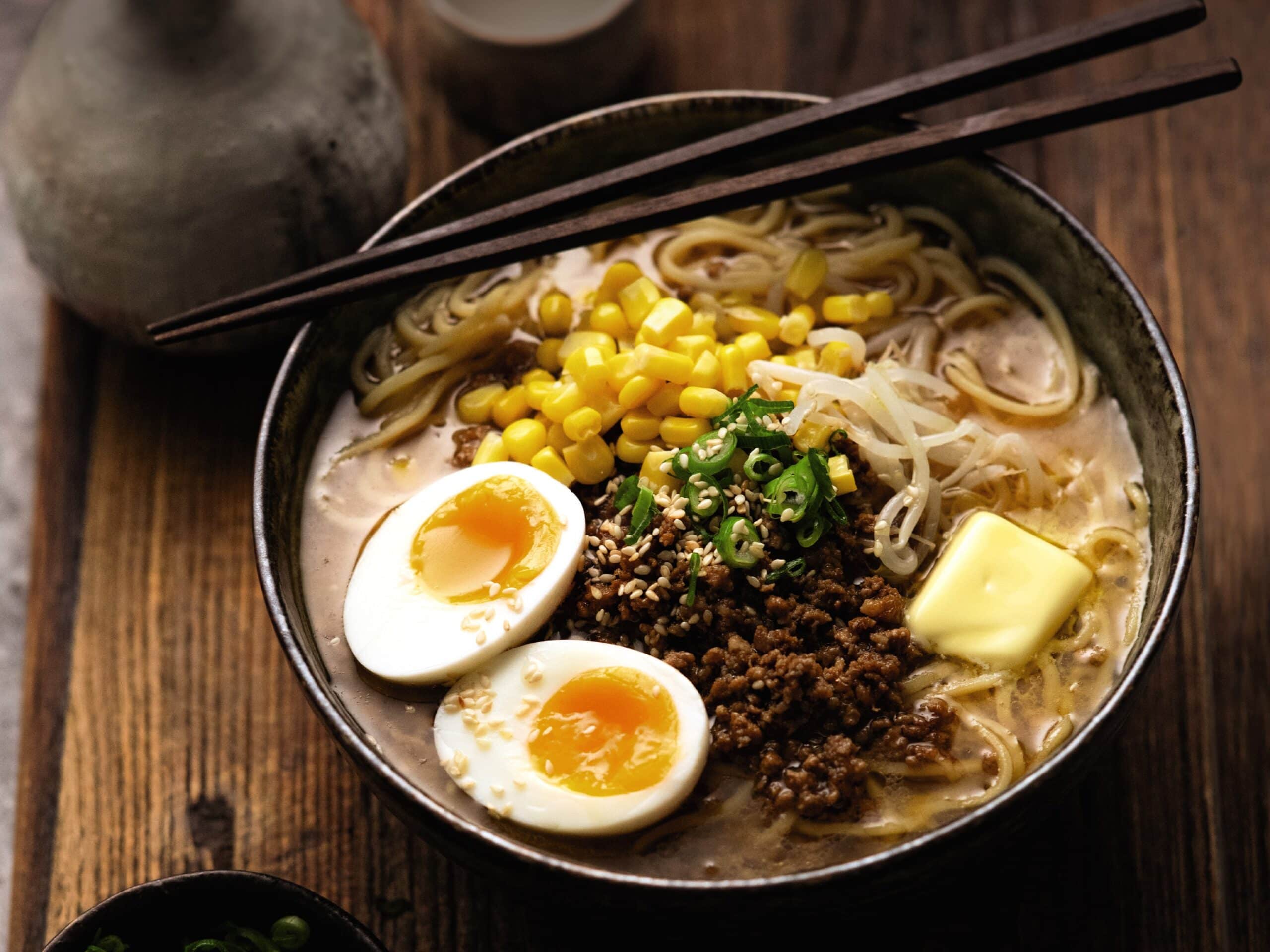
Ramen, the ubiquitous noodle dish that originated in China and found its culinary home in Japan, has become a global sensation. From its humble beginnings as a simple soup with Chinese roots to the innovative and diverse forms it takes today, ramen has captured the hearts and taste buds of people worldwide. This iconic dish, with its rich history and cultural significance, has not only evolved into a comfort food staple but has also left an indelible mark on the world of cuisine. Join us on a journey through 25 intriguing historical facts and numerical trivia that shed light on the fascinating world of ramen, from its early days to its present-day status as a beloved and versatile culinary delight.
Origin of Ramen: The roots of ramen can be traced back to China during the Tang Dynasty, around the 9th century. It initially appeared as a Chinese noodle soup dish called “lamian.” However, it wasn’t until the early 20th century that ramen gained popularity in Japan. Chinese immigrants brought their noodle-making techniques to Japan, and the dish underwent significant modifications to suit local tastes and ingredients.
Introduction to Japan: The first dedicated ramen shop in Japan, Rai-Rai Ken, opened its doors in Yokohama in 1910. This marked the beginning of ramen’s journey to becoming a quintessential part of Japanese cuisine. The dish’s popularity skyrocketed, and various regional styles and flavors began to emerge, contributing to the diverse world of ramen we know today.
Momofuku Ando’s Invention: The revolutionary moment in ramen history occurred in 1958 when Momofuku Ando, a Taiwanese-Japanese inventor and entrepreneur, introduced the world to instant ramen. Ando’s inspiration struck during a period of food shortages in post-war Japan. He aimed to create a convenient, affordable, and easily transportable meal to address these challenges. His invention involved flash-frying pre-cooked noodles and flavorings, paving the way for the instant ramen that is a pantry staple worldwide today.
Cup Noodles Debut: In 1971, Nissin took ramen convenience to the next level with the introduction of Cup Noodles. Momofuku Ando’s genius idea of packaging instant ramen in a foam cup revolutionized the way people consumed this quick and tasty meal. The cup’s design made it even more portable and convenient, contributing to the widespread popularity of instant ramen as a fast and accessible meal option.
Nissin Foods and Top Ramen: Momofuku Ando’s company, Nissin Food Products Co., Ltd., became a powerhouse in the instant noodle industry. In 1970, they launched Top Ramen, a brand that has since become synonymous with quick and affordable noodle soup. Top Ramen has played a pivotal role in popularizing instant ramen globally and remains a go-to choice for millions of consumers.
Shin Ramyun’s Spicy Legacy: Introduced in 1986 by the South Korean company Nongshim, Shin Ramyun quickly gained fame for its spicy and flavorful broth. This instant ramen has become an international sensation, showcasing the global appeal of different ramen varieties. Its popularity not only solidified the place of Korean ramen on the world stage but also contributed to the growing interest in spicy ramen flavors.
Ramen Museum’s Inception: The Shinyokohama Raumen Museum, established in 1994, is a unique cultural institution dedicated to the history and diversity of ramen. Located in Yokohama, it features a nostalgic recreation of a 1958 townscape, the year instant ramen was invented. The museum’s mission is to preserve and celebrate the rich heritage of ramen, attracting visitors from across the globe to explore the world of this beloved noodle dish.
Tokyo Ramen Show: Since 2009, the Tokyo Ramen Show has been an annual event that draws ramen enthusiasts and curious foodies alike. Held in Hibiya Park, this festival brings together ramen shops from all over Japan, each vying for the title of best ramen. It provides a platform for both traditional and innovative ramen styles to be showcased and appreciated by a diverse audience.
World’s Largest Bowl of Ramen: In 2013, a Tokyo-based restaurant set a Guinness World Record for creating the largest bowl of ramen ever made. This colossal dish weighed over 3,000 pounds and featured an impressive combination of noodles, broth, and toppings. This record-breaking feat not only highlighted the creativity within the ramen community but also underscored the dish’s global recognition and appeal.
Ramen Varieties: Ramen comes in various styles, each distinguished by its unique broth, noodles, and toppings. Shoyu ramen, flavored with soy sauce, represents one of the classic styles. Shio ramen, known for its clear and salty broth, offers a lighter alternative. Miso ramen features a rich and savory broth made from fermented soybean paste. Tonkotsu ramen, originating from Kyushu, boasts a creamy pork bone broth. These distinct styles showcase the versatility and adaptability of ramen, catering to diverse palates and preferences worldwide.
Ramen Shops in Japan: Japan boasts a staggering number of over 200,000 ramen shops, each contributing to the rich tapestry of flavors within the ramen landscape. These establishments range from small, local shops serving traditional recipes passed down through generations to modern, innovative eateries experimenting with novel ingredients and techniques. The sheer abundance of ramen shops across the country underscores the dish’s cultural significance and the Japanese people’s deep-rooted love for this comforting noodle soup.
Ramen Consumption in Japan: On average, a person in Japan consumes approximately 45 servings of ramen each year, emphasizing its status as a staple in the Japanese diet. This substantial consumption not only reflects the widespread availability of ramen but also underscores its affordability and versatility, making it a go-to option for individuals from all walks of life.
Ramen in Space: In 2005, Nissin’s commitment to pushing the boundaries of ramen innovation reached new heights when they developed vacuum-packed ramen for Japanese astronaut Soichi Noguchi aboard the Discovery space shuttle. This marked a literal expansion of ramen’s reach beyond Earth, highlighting its adaptability as a convenient and satisfying meal even in the challenging conditions of outer space.
Ramen in Popular Culture: Ramen has woven its way into the fabric of popular culture, making appearances in various movies, TV shows, and anime. One notable example is the film “Ramen Girl,” which explores the transformative power of ramen through the story of an American woman who discovers her passion for the dish in Tokyo. Additionally, the iconic anime series “Naruto” features a character named Naruto Uzumaki, whose love for ramen is a recurring theme throughout the show, further solidifying ramen’s presence in global pop culture.
Ramen Emoji: In 2017, the Unicode Consortium introduced the ramen emoji, a small but significant symbol that encapsulates the dish’s global appeal. The addition of a dedicated ramen emoji reflects its status as a universally recognized and enjoyed food, transcending cultural boundaries in the digital age.
Record for Fastest Ramen Bowl Consumed: Competitive eater Takeru Kobayashi made history in 2014 by setting a record for the fastest consumption of ramen. In a remarkable display of speed and appetite, Kobayashi devoured 55 bowls of ramen in just 10 minutes, showcasing both the dish’s popularity in competitive eating circuits and the extraordinary feats accomplished by skilled speed eaters.
Ramen Burger’s Culinary Fusion: In 2013, Keizo Shimamoto introduced the world to the Ramen Burger, a culinary creation that replaced traditional burger buns with ramen noodles. This innovative fusion dish quickly gained international attention, showcasing the versatility of ramen beyond its traditional form and inspiring a wave of experimentation with ramen in creative culinary circles.
Instant Ramen Museum in Osaka: The Momofuku Ando Instant Ramen Museum, opened in Osaka in 2011, provides an immersive experience into the history and evolution of instant ramen. Visitors can explore interactive exhibits, learn about the invention process, and even create their own custom cup noodles. This museum serves as a testament to the enduring legacy of Momofuku Ando and the impact of instant ramen on global food culture.
Ramen in the Michelin Guide: In 2015, Tsuta, a ramen restaurant in Tokyo, made history by becoming the first ramen shop ever to receive a Michelin star. This prestigious recognition elevated ramen from its humble street food origins to the realm of gourmet dining, signaling a shift in perceptions about the culinary value and complexity of this beloved noodle dish.
Cultural Impact of Ramen: Ramen’s influence extends far beyond the realm of food, permeating various aspects of Japanese and global culture. From art and literature to fashion and design, the dish has become a symbol of comfort, innovation, and tradition. Its cultural impact is particularly evident in the proliferation of ramen-themed merchandise, events, and festivals around the world, solidifying its place as a cultural icon.
Ramen Festival in Shin-Yokohama: The Shin-Yokohama Ramen Museum hosts an annual ramen festival, drawing enthusiasts and chefs from across the globe. This event showcases the diversity of ramen styles and flavors, allowing visitors to sample unique creations from both renowned and up-and-coming ramen establishments. The festival not only celebrates the culinary artistry of ramen but also serves as a testament to its global appeal and the continuous evolution of this beloved dish.
Ramen’s Arrival in the U.S.: The introduction of ramen to the United States is marked by the opening of Hana Japanese Restaurant in 1979 in Dallas, Texas. This establishment paved the way for the widespread popularity of ramen in the U.S., contributing to the proliferation of ramen shops and the integration of this Japanese comfort food into American culinary culture.
Global Ramen Consumption: As of 2022, the global annual consumption of instant ramen is estimated to reach a staggering 103 billion servings. This astronomical figure underscores the worldwide love for this convenient and flavorful noodle dish, transcending cultural boundaries and becoming a culinary phenomenon embraced by people from diverse backgrounds.
Ramen’s Growth in Popularity Worldwide: Ramen has evolved from a Japanese comfort food to a global phenomenon. Beyond its origins in Japan, specialty ramen shops have emerged in major cities worldwide, offering a diverse range of regional and innovative ramen styles. International ramen festivals, events, and dedicated eateries attest to the dish’s universal popularity and its ability to adapt to different culinary preferences.
Expanding Ramen’s Cultural Footprint: Ramen has established its presence in various aspects of global culture. Its inclusion in the Unicode Consortium with a dedicated emoji in 2017 is a testament to its universal recognition and integration into modern communication. As ramen continues to be featured in movies, TV shows, and social media, its cultural footprint expands, influencing not just the culinary world but also the broader realms of art, design, and entertainment. This ongoing cultural impact reaffirms ramen’s status as a beloved and enduring symbol of comfort and innovation worldwide.








